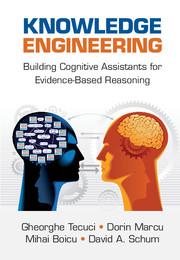Book contents
- Frontmatter
- Contents
- Preface
- Acknowledgments
- About the Authors
- 1 Introduction
- 2 Evidence-based Reasoning: Connecting the Dots
- 3 Methodologies and Tools for Agent Design and Development
- 4 Modeling the Problem-Solving Process
- 5 Ontologies
- 6 Ontology Design and Development
- 7 Reasoning with Ontologies and Rules
- 8 Learning for Knowledge-based Agents
- 9 Rule Learning
- 10 Rule Refinement
- 11 Abstraction of Reasoning
- 12 Disciple Agents
- 13 Design Principles for Cognitive Assistants
- References
- Appendixes
- Index
11 - Abstraction of Reasoning
Published online by Cambridge University Press: 05 September 2016
- Frontmatter
- Contents
- Preface
- Acknowledgments
- About the Authors
- 1 Introduction
- 2 Evidence-based Reasoning: Connecting the Dots
- 3 Methodologies and Tools for Agent Design and Development
- 4 Modeling the Problem-Solving Process
- 5 Ontologies
- 6 Ontology Design and Development
- 7 Reasoning with Ontologies and Rules
- 8 Learning for Knowledge-based Agents
- 9 Rule Learning
- 10 Rule Refinement
- 11 Abstraction of Reasoning
- 12 Disciple Agents
- 13 Design Principles for Cognitive Assistants
- References
- Appendixes
- Index
Summary
Up until this point, the methodology for developing intelligent agents has encouraged the expert to be very explicit and detailed, to provide clear descriptions of the hypotheses (or problems), and to formulate detailed questions and answers that guide the reduction of hypotheses (or problems) to subhypotheses (or subproblems). This is important because it facilitates a clear and correct logic and the learning of the reasoning rules.
The developed agents can solve complex problems through the generation of reasoning trees that can be very large, with hundreds or even thousands of nodes. In such cases, browsing and understanding these reasoning trees become a challenge.
In this section, we will discuss an approach to abstract a large reasoning tree that involves abstracting both hypotheses/problems and subtrees. The goal is to obtain a simpler representation where the abstract tree has fewer nodes and each node has a simpler description. At the same time, however, we want to maintain the correspondence between the abstract tree and the original tree, in order to have access to the full descriptions of the nodes.
STATEMENT ABSTRACTION
By abstraction of a statement (hypothesis or problem), we simply mean a shorter statement summarizing its meaning. Consider, for example, the following hypothesis:
John Doe will stay on the faculty of George Mason University for the duration of the PhD dissertation of Bob Sharp.
Any of the following shorter statements is an abstraction of the preceding hypothesis:
John Doe will stay on the faculty of George Mason University.
John Doe will stay on the faculty.
John Doe will not leave.
The expert needs to define abstractions that are short enough to simplify the display of the reasoning tree while still conveying the meaning of the original hypotheses. One abstraction technique is to eliminate some of the words, as illustrated by the first two of the preceding examples. Additionally, one may abstract phrases by using new words, as illustrated by the last example.
The specific hypothesis, “John Doe will stay on the faculty of George Mason University for the duration of the PhD dissertation of Bob Sharp,” is shown also in the upper-left part of Figure 11.1. As discussed in Section 9.10, from each specific hypothesis Disciple-EBR automatically learns a general hypothesis with applicability conditions, which can be further refined.
- Type
- Chapter
- Information
- Knowledge EngineeringBuilding Cognitive Assistants for Evidence-based Reasoning, pp. 329 - 337Publisher: Cambridge University PressPrint publication year: 2016

